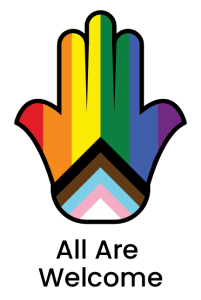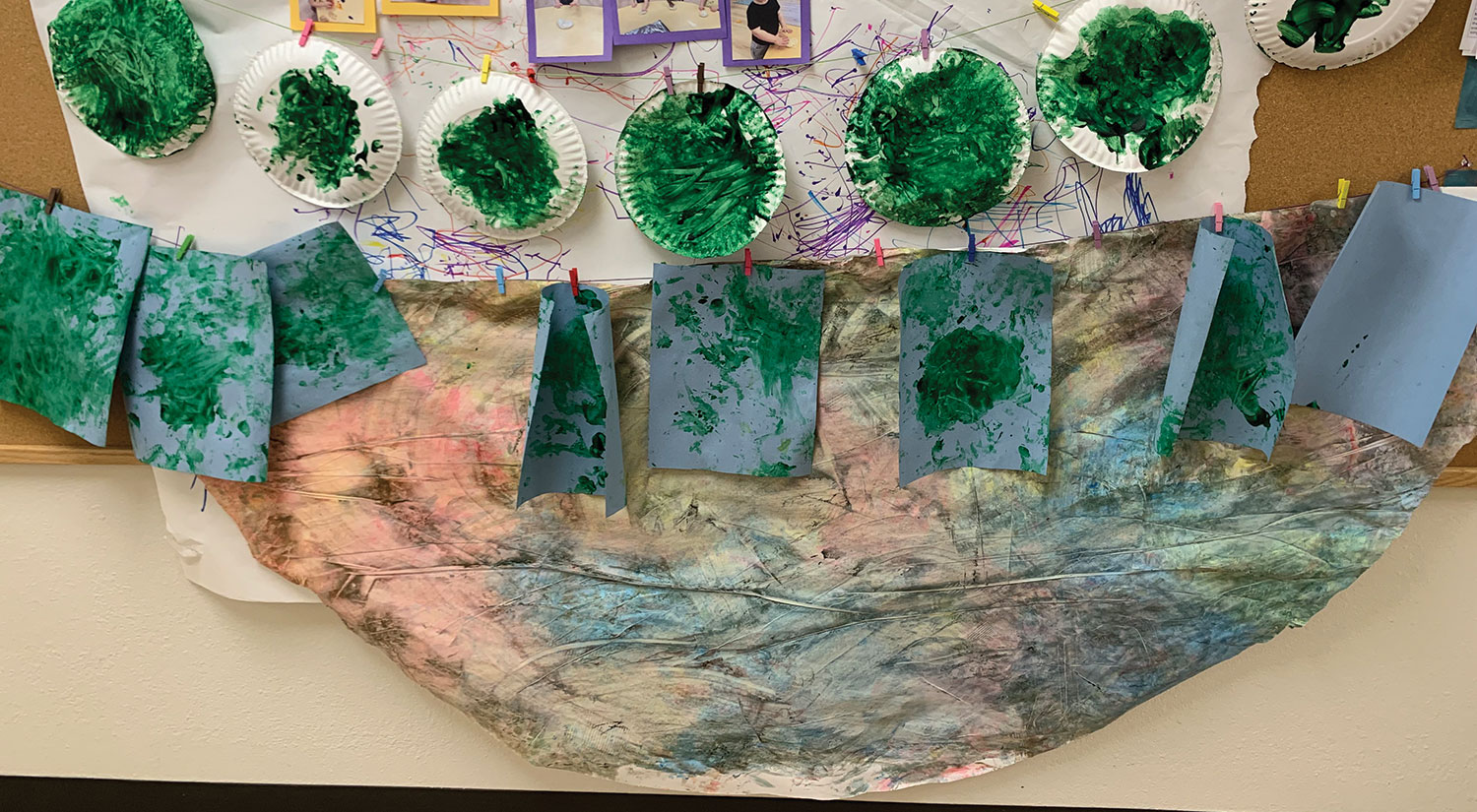
How Children Learn to Read and Write: The Essential Role of Play in the Early Childhood Learning Environment
A collection of artwork created by Shalom Austin JCC Early Childhood Program students.
Photo Credit: Dana Baruch
By Dana Baruch, ECP Faculty Mentor
To the untrained eye, a day in the life of a typical early childhood learning environment/school might look like a lot of playing, eating, diaper changing/bathroom time, sleeping, rinse and repeat. So, one might ask, “Where is the learning? Where is the teaching?”
Understandably, and perhaps even more so during this disruptive pandemic, many parents are feeling anxious about their children’s development—”How does this ‘play-based’ educational philosophy actually work?” and ultimately, “Will my child be ready for kindergarten?”
Consider something that nearly every human masters—learning to walk. For babies, this is a process that typically takes more than a year to do. First, discovering their own bodies (remember when they found their feet for the first time?!), spending time on their tummies to strengthen their back and neck muscles, rolling—first by accident and then on purpose as a form of locomotion, moving up to the plane of hands and knees, cruising around and then pulling themselves up to their feet while holding on to a piece of furniture, and finally, finally they walk and then eventually run on their own!
Now, to consider a more cognitively complex example of learning—that of literacy—reading and writing. When does it begin and how does it progress? What’s the best way to help build literacy skills at school and at home? Like learning to walk, reading and writing require building a series of skills, and the pay-off is astoundingly wondrous. At the Shalom Austin JCC Early Childhood Program preschool, this process is thoughtfully nurtured from infants to pre-k children.
Here is what one might see through the years at the ECP:
Infants: Lots of board books that invite the children in. Pictures of children and their families, and artwork with their names. Lots of music playing and teachers singing. Teachers talking to children, echoing their sounds, asking questions and noticing out loud, “I see you have a hat on today!”
Toddlers: Lots of books for children to read and to listen to at “circle time.” Music playing that guides children’s actions (Dance and Freeze, Head Shoulders Knees and Toes). Art projects that encourage fine motor development (finger painting, holding items to paint with and stamp with). Rhyming words. Sharing books about specific topics. Reading pictures (Where’s the red ball? What animals do you see?). Learning shapes.
Twos: Lots of books (notice a theme?!), music, word plays, songs that rhyme. Sitting for a longer time reading by themselves and listening to books being read. Drawing with sidewalk chalk and painting with paintbrushes and other “tools.” Beginning to notice letters and numbers and identify them. Some children will be interested in trying to draw pictures of things (circles, lines, shapes, people). Some will be interested in trying to write letters in their names.
Threes and Fours: Books in a reading area and often in other centers (the block center might have books about construction, the science center might have books about weather). Writing center with markers, paper, scissors, stickers, etc. Alphabet (and Aleph-Bet) posters and/or rugs around the classroom. Interactive calendars with images and words to identify the months, days, and dates. Teachers work with the children at circle time to learn the cycles, names, and order of the calendar. Often there will be a “letter of the week” that helps children learn organically what words begin with that letter. Children’s art often includes their words about their creations, and names are written with increasing accuracy and precision of letter formation. This age-group loves to create fantastical stories, often illustrating and having teachers write the words the children narrate.
What can parents do to help nurture their child’s literacy development at home?
- Have a literature-rich environment-books, books, books. Have alphabet and number posters, puzzles and games.
- Read to your child every day and make it a sweet, interactive, and relaxed time.
- Provide child-friendly art materials that are easily accessible (paper, markers of different sizes, watercolor paints, etc.)
- Ask your child to tell you about their creations and write down what they say. They might even “write” their own book this way.
- Play music, sing, recite poetry.
- Have letter and number shaped cookie cutters and encourage your child to shape letters and numbers out of playdough (or edible cookie dough!).
- Keep it enjoyable. If you notice your suggestions are being met with resistance or frustration, consider giving your child the steering wheel and letting them take the lead. Remember—Learning that is enjoyed is what most people remember the best.
- Embrace the process—Just as learning to walk takes time, so, too, does learning to read and write. From finger painting to comfortably holding and drawing with a big crayon, to mastering writing a name with a pencil, the process takes time and patience.
One final thought: Play is the “work” of children. As they play, children create, invent, and deepen their knowledge and their skills. Teachers are there to provide a rich environment that encourages and stretches each child’s learning. This learning helps children build confidence and self-esteem that comes from a sense of competence and accomplishment. When children feel confident, they are more likely to be willing to take risks, an essential factor for successful learning throughout their lives.
Latest Posts

Innovative Collaboration Builds Community Resilience for Teens and Their Families
By Dr. Alyssa Gilden and Jessica Ochs Shalom Austin’s Jewish Family Service (JFS) and Youth & Teen Department continue to expand their partnership to provide crucial support to the community’s youth through its Resiliency Roundtable work. This collaboration...
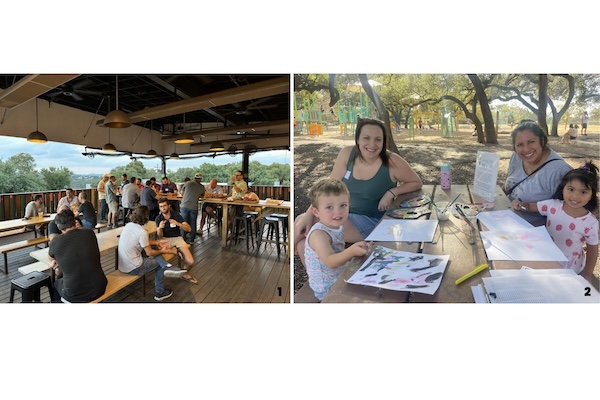
Family Engagement Explodes in Austin Area
Participants enjoy Dad’s Night Out. Credit: Rabbi Dan Ain Participants enjoy a Play and Paint Event. Credit: Allison Granet By Allison Granet and Rabbi Dan Ain In the last several months, young family engagement has grown rapidly, and Shalom Austin is delighted to...
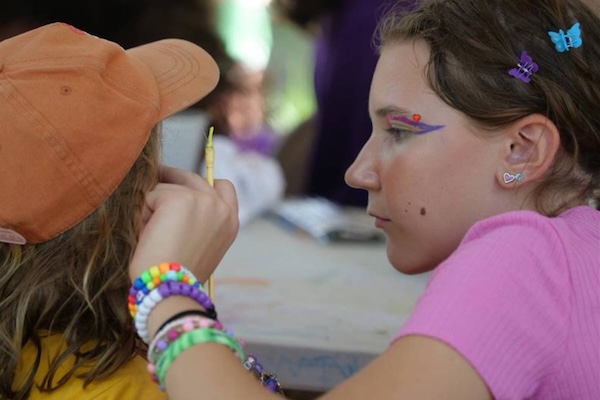
JCamps Debuts New Teen Camp Leadership Program
Madatzim Leader paints a camper's face as part of the teen-led program. Credit: A. D. Schmidt By Caroline Mellow This summer, JCamps debuted a brand-new teen camp program, Madatzim Leaders. This is a leadership-focused camp program for campers entering seventh...

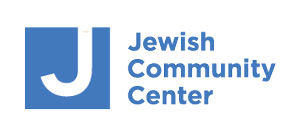
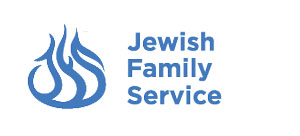
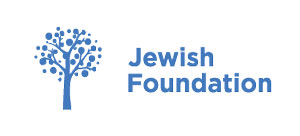
HEALTH & WELLNESS
Fitness
Swimming
Tennis & Pickleball
Sports
EDUCATION
Jewish Culture & Education
Early Childhood Program Preschool
After School & Childcare
Camps
ARTS & CULTURE
Literary Arts
Visual Arts
Theatre & Film
Dance
COUNSELING & SUPPORT
Jewish Family Service
Counseling & Groups
Case Management
References & Resources
Copyright Shalom Austin 2025. Privacy Policy.
